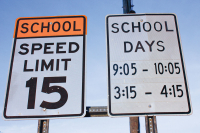Vandalism prompts Sylva to mount security cameras in parks
Persistent vandals have pushed Sylva decision-makers to ramp up the town’s surveillance program.
Coming soon to two Sylva parks are several new security cameras. Both Bryson and Poteet parks have suffered a rash of vandalism, from smashed bathroom sinks to graffiti.
Higher cost for new restrooms at Waynesville playground could nix project
Renovating the antiquated, shuttered restrooms at the Waynesville Recreation Park will cost more than town officials anticipated, leaving them to question whether to bother or just scrap the plans altogether.
Mountain Momma
I have faint but fond memories of picking strawberries as a kid: the twisty, dusty gravel roads leading to the farm, being handed my very own big-girl pail by the strawberry lady and, most notably, sneaking mouthfuls when my mom wasn’t looking.
Macon forges ahead with $1.1 million ballpark
Macon County commissioners narrowly voted last week to buy a 50-acre tract for $550,000 to create a sprawling baseball and recreation complex. It would take another $550,000 to put in the first two baseball diamonds and a parking lot.
From greenways to ball fields, state cuts could sideline local recreation wish list
Statewide parks and recreation funding is clashing with fiscal austerity in the current state budget process, in a showdown that has environmentalists and local governments bracing for the worst.
Changing recreational habits challenge forest service
 The painstaking process of outlining a clear mission for the U.S. Forest Service and how it will manage its expansive public lands in Western North Carolina and the varied — and sometimes competing — interests of the people that use them has begun. Once completed, the new plan will serve as a reference for the coming 15 years on any major decision made about the Pisgah and Nantahala forests in regards to protected wilderness areas, logging, mountain biking, fires, hiking, hunting and more.
The painstaking process of outlining a clear mission for the U.S. Forest Service and how it will manage its expansive public lands in Western North Carolina and the varied — and sometimes competing — interests of the people that use them has begun. Once completed, the new plan will serve as a reference for the coming 15 years on any major decision made about the Pisgah and Nantahala forests in regards to protected wilderness areas, logging, mountain biking, fires, hiking, hunting and more.
Batter up: Macon weighs costs and benefits of proposed recreation complex
A Macon County commissioner, who prides himself on fiscal conservatism, has been staking out his positions lately.
After questioning the virtue of pay raises for Macon County workers two weeks ago, Commissioner Ron Haven has turned his attention to another proposed outlet of government spending: a large sports complex being considered outside of Franklin.
Cherokee leaders make their case for a indoor adventure park
 A $93 million family adventure park in Cherokee would likely turn a profit during its first year of operation, according to early projections from the Eastern Band of Cherokee Indians’ finance department.
A $93 million family adventure park in Cherokee would likely turn a profit during its first year of operation, according to early projections from the Eastern Band of Cherokee Indians’ finance department.
Scouting a Smokies Blueway Trail: Recreation abounds, but knowing where and how to tap it can be a mystery
 The mountains rising above the valleys have long been the main attraction for tourists planning a trip to Western North Carolina, but a regional initiative between local government and private entities is looking to capitalize on the recreational potential riding on the rivers beneath.
The mountains rising above the valleys have long been the main attraction for tourists planning a trip to Western North Carolina, but a regional initiative between local government and private entities is looking to capitalize on the recreational potential riding on the rivers beneath.
Sweet single-track coming to WCU
 Outdoors enthusiasts and diehard mountain bikers are waiting in anticipation the winter opening of a seven-mile mountain biking and hiking trail in the Sylva and Cullowhee area.
Outdoors enthusiasts and diehard mountain bikers are waiting in anticipation the winter opening of a seven-mile mountain biking and hiking trail in the Sylva and Cullowhee area.
The trail will be the first of its kind accessible by foot, or bike, from the Western Carolina University campus and is expected to be a vital link in a recreation system that may one day expand to connect county, regional and even state trails.





